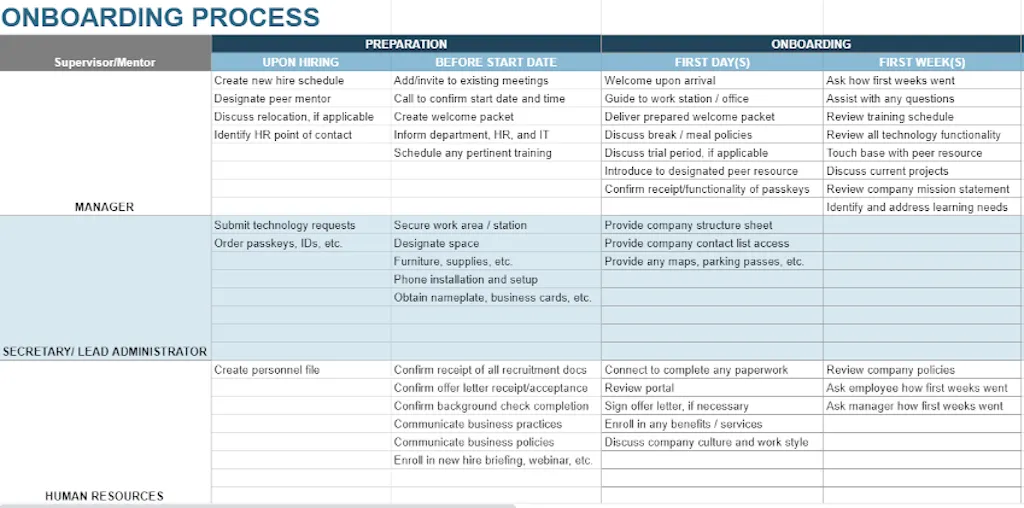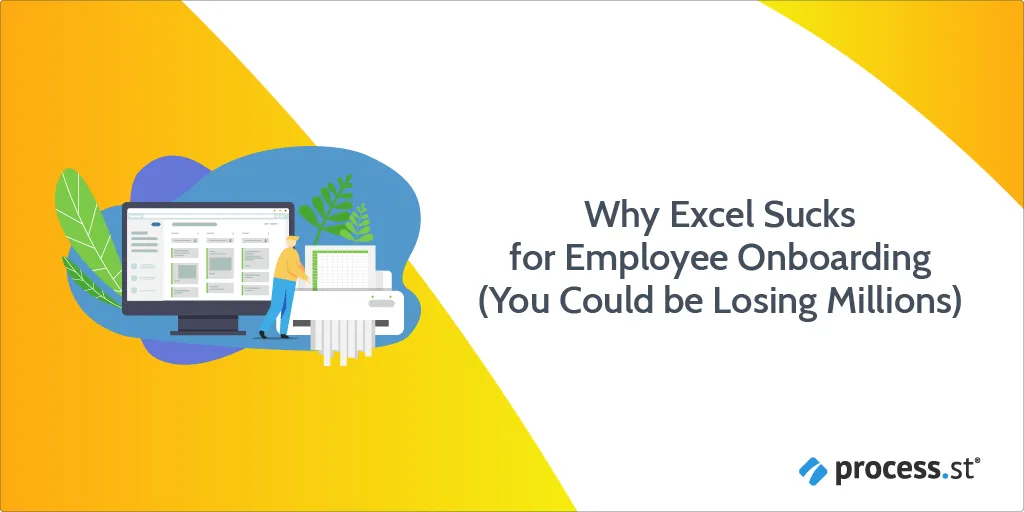Why Excel Sucks for Employee Onboarding (You Could be Losing Millions)
Blog: The Process Street Blog

“Employees in a well-structured onboarding program are 69% more likely to remain at the company after 3 years.” – Society for Human Resource Management (SHRM), 2010 Employee Benefits
1 out of 25 employees leave their new job due to substandard onboarding experiences.
In contrast, a good employee onboarding program can boost employee retention by 69% after 3 years.
Process Street is dedicated to helping our users improve their business operations, and employee onboarding is a prime focus area. On this, we’re surprised to learn that some of our customers have been using Excel for employee onboarding.
According to Harvard Business Review, companies – on average – lose 23% of their new hires after one year. A more thoughtful approach to employee onboarding can dramatically improve this statistic for your organization; and for that, we say, get off Excel.
“…a lot of B2B productivity products are competing with Excel sheets and other products that are totally not built for the specific problem they solve.” – Bram Kanstein, Tech Out Loud, The Product Before the Business by Bram Kanstein
In this Process Street article, you’ll learn why Excel sucks for employee onboarding, and why workflow management solutions offer better onboarding solutions.
Click on the relevant subheader to jump to your section of choice, alternatively scroll down to read all we have to say.
- Scenario: Onboarding using Excel
- 8 reasons why you need to ditch Excel as your employee onboarding software
- Overcoming Excel onboarding limitations with a workflow management solution
Scenario: Onboarding using Excel
Imagine a scenario:
For the first stage of your employee onboarding process, your new hires are required to fill out the appropriate paperwork. The required documentation is sent to your new hire via email. After delivery, you jump into your onboarding Excel file and check Yes under the column heading titled Delivered. You follow this up by checking In progress under the cell column heading Paperwork.
It’s standard procedure to wait four days before requesting these filled-out documents back. However, after two days, you’re looped into an email from your HR team asking the new hire for the documents. You have to relay the four-day rule to the HR department and apologize to your new hire for the confusion via email.
You’ve always questioned the four-day paperwork rule and wondered if it would be better to update your standard onboarding procedures and request paperwork after two days. This would give your HR team more time to process the documents. Yet, due to the confusion already present, you’re reluctant to make this change at the risk of causing more confusion during the onboarding process.
After four days have passed, you have a look at your Excel onboarding spreadsheet to see if the new hire has handed the paperwork in. The appropriate cell still says In progress, so you change the cell color to red to indicate the late documents. You send an email to your new hire stating that you haven’t received their paperwork.
Within minutes your new hire responds, acknowledging they did send the paperwork. You email your HR coordinator to confirm this. She responds apologizing that she updated the wrong cell for a different candidate.
Your onboarding spreadsheet is a large, complex file, so this is understandably an easy error to make. You fix the error, and once again apologize to the new hire for the mix-up.
Due to the multitude of errors already made, your new hire is now questioning your onboarding procedures and is concerned about the security of the information they give you. You have no adequate response, as your Excel sheet is not inherently secure.
As you can tell, the above scenario is plagued with poor onboarding practices. From defective communication between departments, human error slowing processes down, and security issues being raised. This scenario illustrates why Excel sucks for employee onboarding.
As stated by Bram Kanstein, CEO of No Code MVP, many businesses are utilizing tools that weren’t built for the purpose they’re using them for. These tools may seem good enough to perform task X, but are fraught with issues and inefficiencies. Excel is a prime example of this. Most people use Excel because they aren’t aware that other, better options are available to them.
8 reasons why Excel is bad employee onboarding software
A 2020 UK government Excel error led to up to 48,000 COVID-19 cases not being accounted for.
“This isn’t just a shambles, it’s worse than this. It gives me no comfort to say it, but it’s putting lives at risk.” – Shadow Secretary Jon Ashworth MP, UK Covid crisis: ‘Up to 48,000 could have spread virus due to Excel error’ | ITV News
Granted, we’re not dealing with government-level information, but Excel mistakes in business can be as devastating financially. For instance, mixing start dates with monetary values has led to employees receiving financial bonuses of up to $55,000 – a human error that may have been good for the employees, but not the company.
But human error is only one out of the many issues associated with using Excel in business, as you’re about to find out.
It’s estimated that 800 million people use Excel.
As a tool, Excel and spreadsheets were cutting edge in say, the 80s, but should they have a place in business today? Think about the walkman, the satellite phone, and the disposable camera. These were technologies also invented around the same time as Excel – how often do we use these technologies in the 21st century?
For HR departments, there are other options that do a better job at keeping track of onboarding information – and they’re more enjoyable to work with.
Spreadsheet applications are becoming – and some would say are – obsolete by the emergence of new SaaS platforms. These are process-specific solutions, that can organize data and present insights far easier than spreadsheet-driven labor.
All in all, Excel sucks for employee onboarding, and listed below are the top reasons why.
Reason #1: You need to capture onboarding as a process 
Employee onboarding is defined as:
“A process of familiarizing a new employee with the organization. Onboarding begins from the moment an offer is made to the employee until the time the employee becomes a productive member of the organization.” – ToolBox, What Is Employee Onboarding Process? Definition, Templates, and Best Practices
Employee onboarding is a process and needs to be represented as such for successful management.
Excel is an in-the-moment, snapshot data entry platform. It provides little information regarding onboarding operations, aka:
- What tasks are being done and by whom;
- Areas to improve;
- What stage the employee is at regarding their onboarding journey;
- The progress of different departments involved in the onboarding processes.
For this, you need a SaaS workflow management solution, one that captures the flow of onboarding tasks. You need to document employee onboarding as the process it is, and standardized your onboarding strategy.
Reason #2: You need a standardized onboarding strategy 
If you read my previous article, Improve Employee Retention by 82% With These 16 Onboarding Best Practices, then you already know how to create successful onboarding processes. But how exactly do you execute these best practices in order to maintain their implementation on a company-wide level?
That comes from documenting your processes. Sending these documented processes around your team secures teamwide effort in following your onboarding strategy to the T.
Organizations with a standard operating process report a 50% greater new-hire productivity. A lack of standardization causes issues, such as inefficient information about payroll/salary and the breakdown of communication lines with supervisors.
Excel does not have the capability to monitor if your teams are completing their tasks as needed and in the correct order. In addition, Excel doesn’t have the option of sending notifications for tasks due, or non-completed tasks. This makes it difficult to manage the onboarding processes and maintain ongoing standardization.
Reason #3: You need to coordinate activities between different departments 
Employee onboarding involves multiple levels within an organization, including pre-onboarding, corporate onboarding, and departmental onboarding. Each onboarding level provides unique value and contributes to a comprehensive experience for your new hires.
Excel only allows one person to make changes and edit at a time. Even Google Sheets – introduced as a solution to this – doesn’t work as a natural collaboration tool. For example, users working on the spreadsheet at the same time can end up saving older versions over newer iterations.
What’s more, Excel – both offline and online cloud-versions – has no function for instantaneous communication. This makes it difficult to notify team members of completed tasks, problems, or changes to standard procedures.
Reason #4: You need to remove the potential of human error 
Excel and spreadsheets are often a one-time thing, done by someone with no formal spreadsheet training. It comes with little surprise to learn that 90% of spreadsheets have errors, costing U.S. companies millions.
With Excel, a slightly misaimed mouse click could mess up a formula and undo years of formula building. Once more, these errors are difficult to spot. There’s the danger of relaying incorrect information to your new hire, and for decisions to be made based on inaccurate data.
J.P. Morgan reported $6.2 billion losses in 2012 due to Excel flaws. The error crept into the Excel sheets data as a copy-and-paste mistake, which bypassed necessary process steps. This error emphasizes how easy it is to slip up when using Excel, the importance of following the process, and the monetary losses it can cause.
Reason #5: You need to have full security control 
Excel is not inherently secure.
This can be a big issue during onboarding, with your HR department holding sensitive employee information. It falls on the company to make sure employee data is protected, and spreadsheets are not the best way to do that. There’s no way to employ fine-tuned control over can see what and when. How do you prevent individuals with full access from sending important information to others?
This happened for the airline manufacturer Boeing. In 2017, it was reported that an employee sent his spouse a spreadsheet containing employees’ names, Social Security numbers, birthdays, and code numbers. The security break affected 36,000 workers in four states. This set off a cybersecurity breach; one that could have been prevented if Boeing used a more secure SaaS tool for housing its employees’ information.
Reason #6: You need to save time 
Excel demands manual data entry, stripping productive time away from team members and new hires. This productive time could otherwise be used to focus on business goals, optimizing onboarding procedures, or expand employee training.
For example, during a summer internship, I was an assistant researcher for an ecological project. Excel was used to store analytical data, and it was my job to keep the Excel file up-to-date and generate reports. The fact that they had to hire an intern with the sole purpose of looking after the Excel file, to me, highlights the time-sapping nature of the tool.
This was picked up on by the project leader, who later tried to move analytical procedures onto a more advanced statistical software package. He knew that by doing this, he would save both time and money; there wouldn’t be the need to hire an intern to look after the Excel document!
Reason #7: You need flexibility for continuous improvement 
Excel is flexible in its coding potential, but relative to other advanced workflow management tools, its adaptability is limited. New files and formulas have to be created to provide the onboarding pliability that’s sometimes needed. This makes it harder to change and improve onboarding processes.
The data-focused nature of Excel fails to lend itself to handling employee turnover. As employees leave, and new employees are hired, team skill sets, experience, and proficiencies are subject to large degrees of variation.
Onboarding flexibility is needed to match the continuously changing skill base against role needs to meet business goals. What’s more, the more a company grows, the greater the employee turnover, and the larger the demand to have a flexible, unified solution. In this sense, Excel can hinder organizational growth.
Reason #8: You need to remove limits to international growth 
Language barriers, inflexibility regarding document change and sharing, and collaboration limitations present obstacles when hiring across different continents. This is on top of having more and more employees with limited ways to monitor what they’re doing and an already stretched management team.
Anything that hinders international growth isn’t good for business. For one, the talent pool that you hire from is reduced. It’s better to have software designed to handle remote onboarding for you to assess candidates on a global level.
Hiring across regions also gives you entry into new markets. You can leverage your new hires to better understand the wants and needs of customers in these regions, e.g. Local workers will understand the language and customs of the new markets, and will operate in the same time zone. Using tools that are better suited to hiring remotely allows you to build regional centers as you expand your team. If your competition is using a flawed Excel system, it’s easy to fathom how you can gain a headstart with a workflow management onboarding solution.
Overcoming Excel’s onboarding limitations with a workflow management solution
The primary reasons people choose to stick with simpler, more manual spreadsheet methods to onboarding were:
- The initial costs of alternative onboarding software solutions.
- The difficulty of using these solutions.
- The accuracy concerns surrounding them.
Luckily, times are changing, and workflow management SaaS software is accurate, cost-effective, and easy to use.
Consider Process Street for instance. Like other workflow management solutions, Process Street doesn’t come plagued with the same onboarding issues associated with Excel.
Let’s look at how Process Street and other workflow management solutions combat Excel’s onboarding issues:
- Capture the onboarding process

As the name suggests, workflow management software captures onboarding as a sequence of tasks to be completed in a specified order, by the relevant person at the right time. In Process Street, you document your onboarding process in a checklist format using our no-code software. - Standardize your onboarding strategy

Standard onboarding procedures give a clear, concise set of instructions for your onboarding team. Workflow runs act as your standardized onboarding procedures to be distributed and adhered to by team members. - Coordinate activities between different departments

You can use Process Street’s workflow Run Link feature to send onboarding procedures to different departments for full internal process transparency. Process Street’s Role Assignments feature enables team members from multiple departments to be assigned to an onboarding workflow. Our Approvals feature allows supervisors to give the go-ahead or rejection on an important item. e.g. new hire documentation. With the addition of these features, you can see how workflow management software is built around inter-departmental collaboration. - Remove human error potential

Okay, it’s impossible to completely remove human error. People will always be there and at risk of making mistakes. Yet, documenting onboarding procedures using workflow management tools breaks down tasks into bitesize chunks that are easier to complete, and acts as a form of task reminder, limiting slipups. - Implement full security control

Cybersecurity is a process, not an event. The best way to ensure security is to build security threats into your onboarding workflow, which is easy when using a workflow management solution. For instance, Process Street has features such as our Task Permissions feature, which controls who can see specific tasks and information. - Save time

By reducing human error, streamlining collaboration between teams, and standardizing operations, workflow management tools save time. Documenting your onboarding procedures in Process Street offers the transparency needed to identify time-consuming tasks and bottlenecks. - Be flexible for continuous improvement

It’s easy to jump into a workflow to change and improve your onboarding procedures. As your teams are referencing the same workflows, they’ll be able to see the improvements made without the need for back-and-forth explanations. When editing checklists in Process Street, all relevant active and future workflows are updated with immediate effect. - Remove limits to growth

In Process Street, multiple people can work from the same workflow at the same time. A cloud copy of the workflow is made each time a team member runs an active workflow, bearing no association with the same workflow run from another’s account. Once more, geographical barriers to growth are removed. Language can be easily updated by editing and updating the workflow. Onboarding workflows are accessed from the cloud by anyone from anywhere.
Process Street employee onboarding process vs. Excel employee onboarding process
Below is a snapshot of an employee onboarding process documented in a Google spreadsheet:

As you can see, it’s difficult to see what tasks need to be completed, by whom and when. There’s no process flow, and it’s not user-friendly.
Compare this with Process Street’s onboarding process below. Tasks interlink and are ordered making it user-friendly. Once more, members for the relevant department are assigned to their unique tasks, meaning the workflow acts as a central hub coordinating activities between departments.
Click here to access our Employee Onboarding Checklist!
If you’re still set on using spreadsheets as a form of data storage, I recommend you integrate your spreadsheet with their associating onboarding workflows via Process Street. That way, Excel is left to do what Excel was designed to do – store data. And Process Street looks after the critical onboarding processes feeding your Excel sheets with this data.
Learn how you can use Process Street with Excel or Google Sheets here!
How do you control your employee onboarding processes? What problems have you faced when using Excel? How did you solve these problems? Let us know in the comments below!
The post Blog first appeared on Process Street | Checklist, Workflow and SOP Software.

